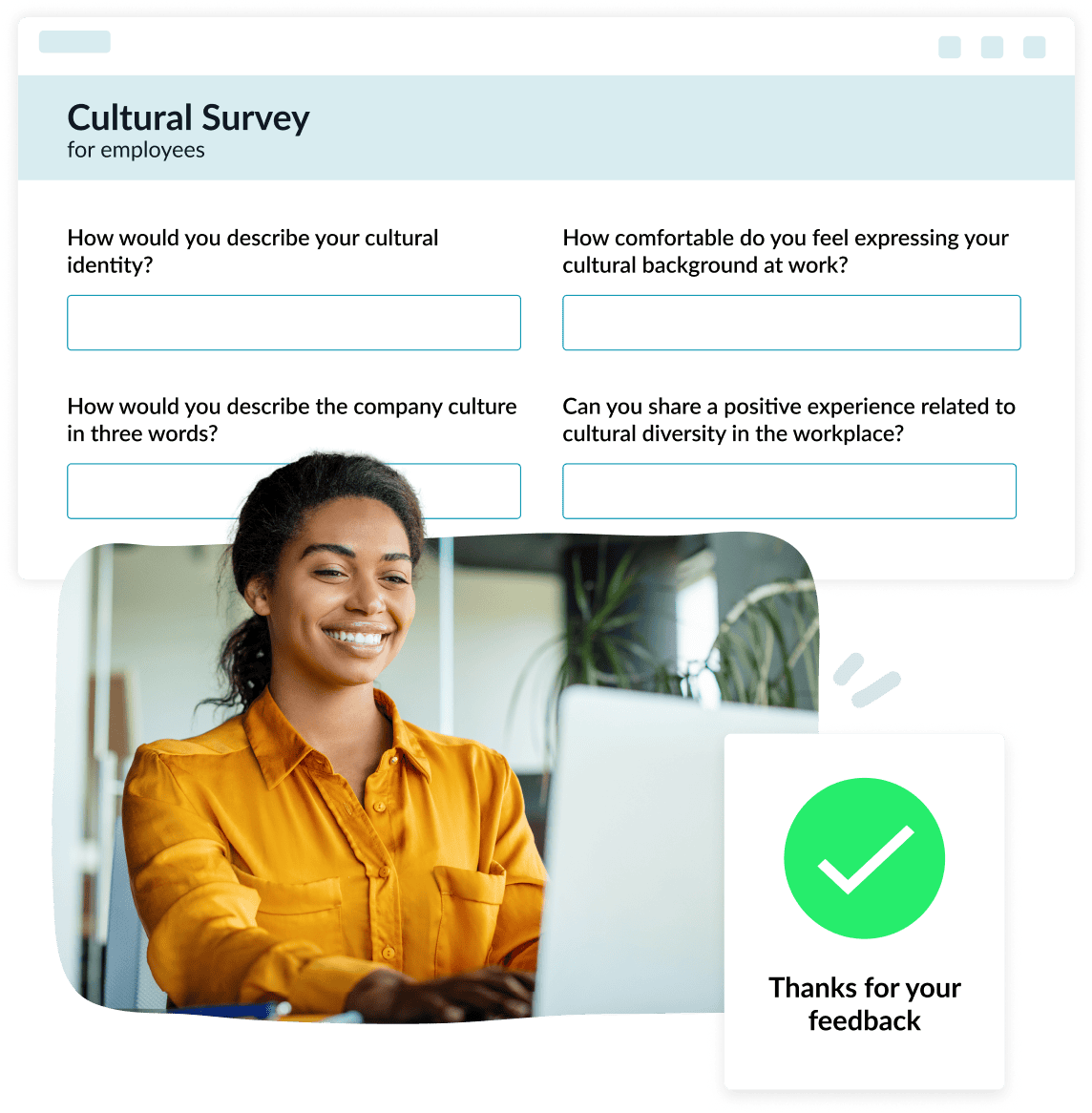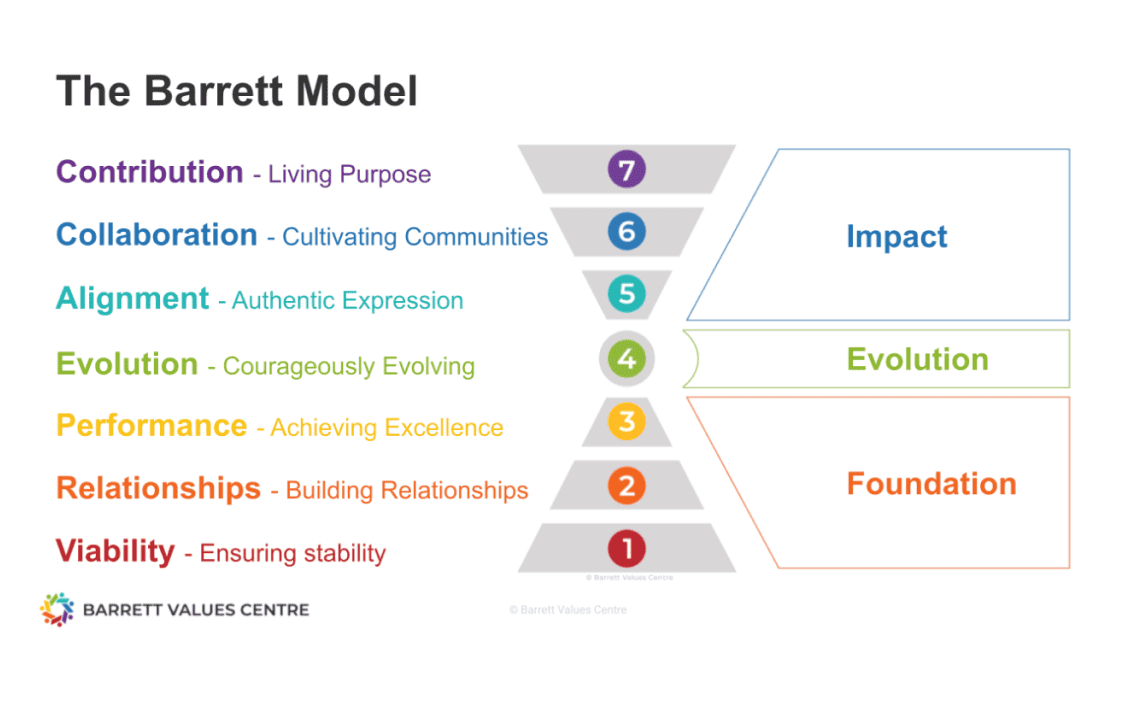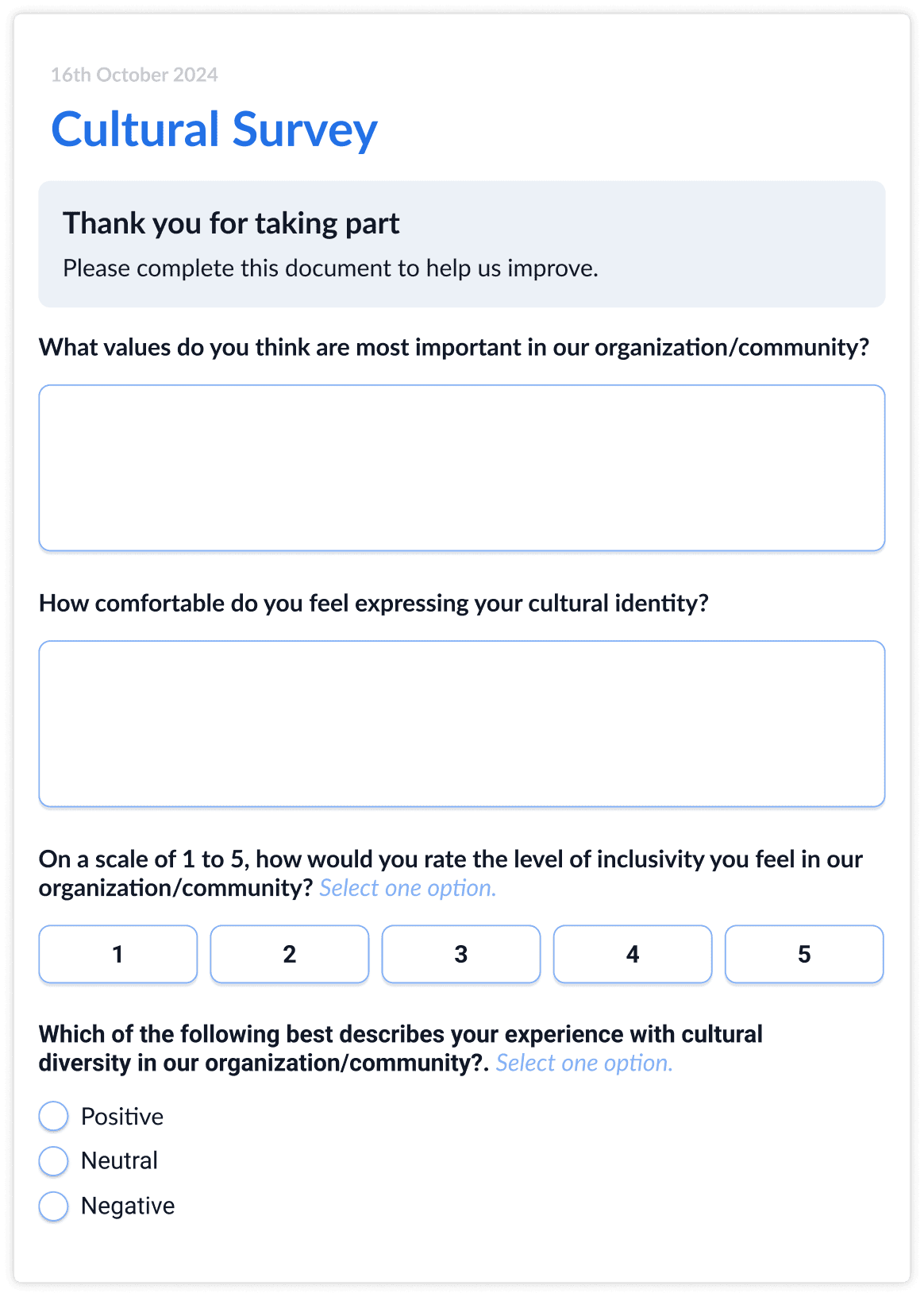
How To Conduct a Structured Interview
Learn how to conduct structured interviews effectively with our comprehensive guide.

Cultural assessments are internal processes through which organizations evaluate their culture. The assessment aims to determine how well the culture serves employees and areas that need improvement. Cultural assessments are crucial for organizations in today’s diverse, globalized work environments because culture defines the organization's identity and is critical to attracting and retaining talent.
A job seeker study showed that 46% consider the company culture very important when looking for a workplace.
Another survey found that one of the major reasons people quit their jobs is toxic work culture.
Cultural assessments help to identify the gaps in the existing organizational culture and where the leadership wants the culture to be. Here are some of the benefits of cultural assessments:

Problems with culture are not always easy to notice and are usually discovered when consequences such as lateness, absenteeism, burnout, gossip, and communication breakdown become evident. Cultural assessments help to uncover concerns with organizational culture before bigger challenges arise.
Workplace cultural problems are usually caused by deep-seated issues that have festered over time. Factors such as lack of communication, prejudice, bias, favoritism, and even inept leadership lead to cultural issues, and a cultural assessment can help unearth these underlying causes.
A cultural assessment can also identify areas in which the organization is getting its culture right and how to improve on these areas. For example, an organization with flexible work programs as part of its culture might create more options that suit employees according to their individual needs.

Follow these steps to carry out a cultural assessment.
The goals of the assessment program should be clearly defined. The assessment may be aimed at creating an environment that attracts and retains talent, improving team dynamics, or aligning the culture with leadership vision and organizational strategy.
There are several cultural assessment methods and tools including the Organizational Culture Assessment Instrument (OCAI), organizational culture surveys, pulse surveys, performance metrics and focus groups.
Employees need to be aware of the assessment process and what is required of them. Feedback must be provided on concerns employees may have, such as anonymity of the surveys. Communicate all aspects of the process before commencement.
Surveys should be carried out and all necessary information gathered.
Aside from information gathering from employees, other aspects of the workplace must be evaluated, such as the organization’s goals and vision, management and operational policies, the physical workspace, leadership perspectives, and the organization’s online or social media presence. Employee behavior at work should also be observed.
Analyze the collected data. This could be presented in a dashboard for easy visualization and understanding.
Prepare the report of the assessment process to include all findings, data and recommendations, for presentation to management.
Several types of methods and tools can be used for cultural assessments. These include:
This is an effective tool that measures an organization's culture based on the Competing Values Framework developed by Kim S. Cameron and Robert E. Quinn. The framework identifies four distinct culture types, namely:
Adhocracy culture:
This is an entrepreneurial culture usually found in start-ups that emphasizes innovation, risk-taking and adaptability. Adhocracy encourages employees to be creative, open-minded and flexible.
Clan culture:
This culture creates a family-like environment at work and there’s usually teamwork, collaboration and employee participation in decision-making.
Hierarchy culture:
This is the traditional corporate culture where there’s a clear chain of command and management levels. The work environment is stable, efficient and has formal procedures. It often adopts bureaucratic structures.
Market culture:
Market culture prioritizes competitiveness, profitability and results. It emphasizes the achievement of goals and leadership focuses on efficient and effective execution.
This assessment tool is in the form of a survey administered to employees to rate their agreement or disagreement with the statements on culture. It provides insights into strengths and weaknesses of the organization and makes recommendations for cultural improvement. This tool is a comprehensive tool that measures culture in the following 4 areas:
Mission:
Assesses the organization’s vision, strategic direction, and goals.
Consistency:
Measures the alignment of processes, systems and actions with organizational goals and values.
Involvement:
This evaluates teamwork, employee involvement in decision-making, employee development and empowerment.
Adaptability:
Assesses the ability to respond and adapt to change. It assesses flexibility, innovation, and the organization’s learning capacity.
The Barrett Values Centre’s tools help organizations assess their culture as well as values and vision. This Cultural Transformation Tools, CTT, assesses the current culture and helps to identify areas that need improvement. The CTT assessment also produces detailed reports and recommendations that help improve company culture.

Image from Barrett Value Centre
These measure employee perceptions of the organization’s culture, and areas such as communication, teamwork, and leadership are assessed. There are also pulse surveys which are regular, quick surveys sent to employees to obtain continuous feedback.

Interviews provide a clear understanding of employees' values, beliefs and work ethics, to determine if they align with the organizational culture. Interviews can be conducted one-on-one or with focus groups of selected individuals across departments in the organization.

For cultural assessments to be effective, it is important to ask the right questions that will elicit responses that provide insights into challenges and opportunities. Here are some examples of questions to ask during a cultural assessment.

To evaluate the results of a cultural assessment, these steps can be followed:
Analyze quantitative data
The data collected from surveys and other cultural assessment methods are analyzed to identify trends or patterns. Compiling the scores for each question will show the general sentiments in the organization. High scores indicate positive perceptions while low scores reveal areas that need to be paid attention to.
From this analysis, you can see the distribution of the responses in percentages, and according to departments, hierarchy, gender, and other demographics you want to use. For example, some departments might record high satisfaction levels while others may highlight problems.
Analyze qualitative data
Qualitative data collected from interview responses and observations will provide insight into the assessment. Analysis can be done according to recurring themes such as communication leadership, inclusion and work-life balance. Qualitative data analysis can also be based on positive, negative or neutral feedback. Include specific examples or stories shared by employees to provide context for understanding the themes and issues.
Evaluate the gaps between the current and desired culture
Assess how closely the current culture aligns with the values the organization wants to uphold. Employee perceptions in the survey must align with such values. If not, there’s a disconnect that should be addressed. For example, if inclusion is a value the company seeks to foster, and the survey shows that most employees feel excluded, you need to identify the causes and propose solutions in the recommendations.
Identify major strengths and areas of improvement
It’s important to note areas where there are high scores and positive feedback. These are areas of strength which can be leveraged to improve other aspects of the culture. For example, a leadership that listens and encourages feedback can enhance other aspects of the culture such as recognition and work-life balance.
Areas of the assessment with low ratings and negative feedback require special attention and interventions. For example, if the leadership’s view of the culture differs from the assessment’s feedback, it shows a misalignment and leadership may need to adjust their approach or communication.
Benchmark results against industry standards
Compare the results of the assessment with others in your industry for insight into how well your culture is doing. If external benchmarks are not available, do periodic assessments and compare your results over time to measure changes.
Communicate the results to management
A report of the cultural assessment should be presented to management. The report should contain an action plan as follows:
Track the progress
This can be done by periodical assessments and collecting employee feedback.
A cultural assessment is a process of evaluating an organization's values, behaviors, and workplace norms to understand how employees experience the culture. The assessment is important because it identifies areas of strengths and weaknesses and it provides insights into how such weaknesses can be addressed. It also provides insights into employee engagement, leadership effectiveness, and alignment with company values. Cultural assessments help organizations to create a more productive and supportive work environment.
Cultural assessment questions include a mix of quantitative and qualitative questions, which cover leadership, communication, teamwork, inclusivity, and alignment with company values. Employees may be asked to rate leadership effectiveness, describe their experiences with communication, or assess how well the company promotes diversity and inclusion. Open-ended questions allow employees to share specific experiences or suggestions.
The data collected from cultural assessments is analyzed to identify gaps and trends in the culture. The leadership uses the results to develop strategies that will address issues, which will in turn improve employee morale and align culture with business goals. These insights are vital for creating action plans that focus on improving communication, employee engagement, and overall work environment.
Cultural assessments are most effective when conducted annually or bi-annually. Regular assessments allow companies to track cultural shifts, address emerging issues, and ensure continuous alignment with organizational values and goals.
The benefits of cultural assessments include improved employee engagement, better organizational alignment, enhanced leadership insights, increased inclusivity, and actionable feedback to improve the workplace culture.
Modernize your hiring process with expert insights and advice.